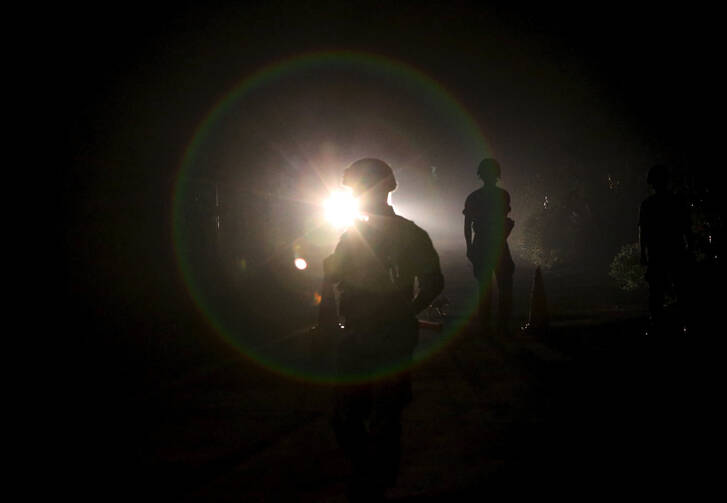Micro-Accord
A statement of regret from a political leader may seem like a minor diplomatic breakthrough, but when the country in question is the autocratic and nuclear-armed North Korea, it is cause for tentative hope. After a tense few days in August, in which North and South Korea were threatening aggression following the maiming of two South Korean soldiers by a land mine, the two sides agreed on a brief accord that ended the crisis. After over 40 hours of negotiations, the South promised to end its propaganda broadcasts directed at the North, while Pyongyang issued its statement of regret.
How long the hard-won truce will last is unclear. The two sides have been fighting for so long that it does not take much to reignite tensions. Already North Korea is complaining that its statement has been reported as an apology. One piece of good news is that both sides continue to work together to facilitate the reunification of families divided by the Korean War. The current president of South Korea, Park Geun-hye, also remains committed to better relations with the North.
President Park is hopeful that the latest accord can serve as the start of fruitful dialogue. Perhaps; but the issues the two Koreas face are challenging, to say the least. The six-nation talks aimed at ending North Korea’s nuclear program are officially on hold, and the United States has been reluctant to engage with North Korea on this issue. Iran is now the focus of U.S. nuclear negotiations, but North Korea should not be forgotten. It reportedly has the capacity to launch a warhead that could reach the United Kingdom. The accord with South Korea may be a small victory, but it would be foolish not to try to build on it.
Women Leading Worldwide
In 1995, at the United Nations Fourth World Conference on Women, world leaders set a goal: In 20 years women would make up 30 percent of national legislatures. Two decades have now passed, but the hoped-for results have yet to be achieved. A report issued by the Inter-Parliamentary Union has found that only 44 legislatures were able to reach the goal. The United States is among the 146 nations that did not. This failure comes in the midst of a call for better representation of women at the United Nations. Many member states have pushed to appoint a woman to the role of secretary general, which would be a first for the intergovernmental organization. A female secretary general could offer the perspective and priorities needed to encourage more nations to embrace female leadership.
The 30 percent goal is not a random one. Sociologists say that is the percentage needed for a minority group to truly play a role in relation to the majority. Gender-based quotas have helped many nations to achieve greater parity in their legislatures. Such quotas seem unlikely to be embraced in the United States, but other solutions are possible. Encouraging political participation and activism among girls at a young age through programs like Model Senate, Mock Trial and the Model United Nations can help spark an early interest in politics and law. But supporting female politicians is even more vital, especially at the local level. Studies have shown that women are less likely to have the connections needed to raise campaign funds quickly, and many may be discouraged by the cutthroat nature of campaigns. Greater public funding for local campaigns and grassroots support for female candidates could help women get the footing they need to make a difference.
Overexposed
On Aug. 26, Vester Flanagan shot and killed a reporter and a cameraman, Alison Parker and Adam Ward, during a live local news broadcast in Virginia. A video of the shooting was immediately shown on major news networks and various social media platforms. Facebook and Twitter accounts allegedly belonging to Mr. Flanagan showed video from the shooter’s point of view. How do journalists and audiences cope with exposure to such traumatic news and footage?
A study in the United Kingdom found that out of 189 men and women exposed to violent media images, like videos of the terrorist attacks on Sept. 11, 2001, and school shootings, over 20 percent were negatively affected. Percentages were higher among reporters. Gene Demby, the lead blogger for NPR’s Code Switch blog and an African-American, recently wrote about the effect on black reporters of reporting on black deaths. Demby describes reporting as extremely stressful. He writes, “We don’t stop being black people when we’re working as black reporters.”
It is difficult to censor these images, especially in the age of social media, where trigger warnings are provided as small courtesies. While the trauma of watching and reporting on news events can be overwhelming, it has proven crucial for social justice movements in the 21st century. The Black Lives Matter movement, for example, has been able to draw attention to the growing number of deaths of unarmed African-Americans at the hands of police officers, like the deaths of Samuel DuBose, Walter Scott and Eric Garner. Footage recorded by bystanders and circulated on social media platforms can stir consciences and call viewers to action, even if that action is nothing more than a retweet.








